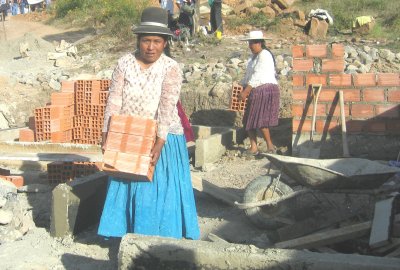- Richard Birk
- Posted On
Birk: My Bolivian journey

I have just returned from a journey to Bolivia, where I participated in a Habitat for Humanity project to build homes in that impoverished country.
Bolivia is a landlocked country in South America, the poorest country on that continent. Although blessed with the majestic mountains of the Andes and Lake Titicaca, a large portion of the population of 10 million lives in substandard conditions.
Most of those affected are the indigenous Indians who make up 60 percent of the population. Many have to live in unhealthy adobe huts with dirt floors, no water, no sanitation services, no electricity, and many families are forced to live in only one room.
For two weeks I and other volunteers carried bricks and rocks up a steep hill, hand mixed concrete, dug trenches – all at an elevation of 9,000 feet, sometimes in the rain. The work was very strenuous, but working alongside the future homeowners made the work so much more rewarding.
Did I sweat? Yes. Did I have a sore body? Yes. Was I tired? For sure, but the personal rewards were priceless.
The local Bolivian people were very grateful and motivated to improve their living conditions as exemplified in how hard they worked on building their homes. Something else that was apparent was that by being there we renewed the idea that others do care and we were a messenger of hope.

Just before departing on the last day of work, I said to the grandfather of one of the future homeowners whom I had been working alongside for several days, “Hasta luego” (see you later). His face grew a big smile and he grabbed me and gave me a big hug. With that he was saying “thank you” for not forgetting them in the future, and thereby giving hope for a better life.
I knew then that I could never forget the plight of those less fortunate in this world and in particular the people of Cochabamba, Bolivia.
The travel to Bolivia is via a long flight to La Paz, where the airport is at an elevation of more than 12,000 feet.
As an American I was very proud to find so many people from our country assisting in making a better life for the people of Bolivia. On the flight to La Paz I sat next to a fellow who had made it his mission to help the poor rural natives find a better way to grow and store potatoes, which is one of their major staples, without which they could starve. Also, on the same airplane were a group of American volunteers associated with the nonprofit Operation Smile, who specialize in surgically correcting children born with cleft palates and other facial deformities.
In the town where we worked, Cochabamba, I met another American, a professional civil engineer, who has dedicated his life to serving the poor by helping bring drinking water to many of the small villages located in the high plateau regions. This is what America is really about.
Regarding Habitat for Humanity, we operate in Bolivia and in more than 90 other countries. Most of the funding needed for these efforts comes from the individual Habitat affiliates in the United States.
We here at Habitat for Humanity Lake County have funded to our international operations enough money to support the purchase of materials for five homes, which average $4,500 each.
If you are interested in volunteering/donating here in Lake County and/or in our international work please call us at 994-1100.
Richard Birk is president of Habitat for Humanity Lake County.
{mos_sb_discuss:4}







